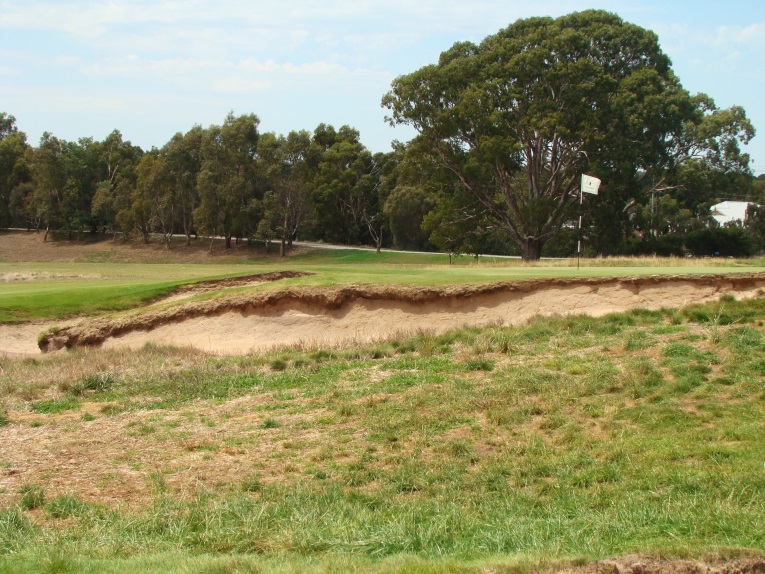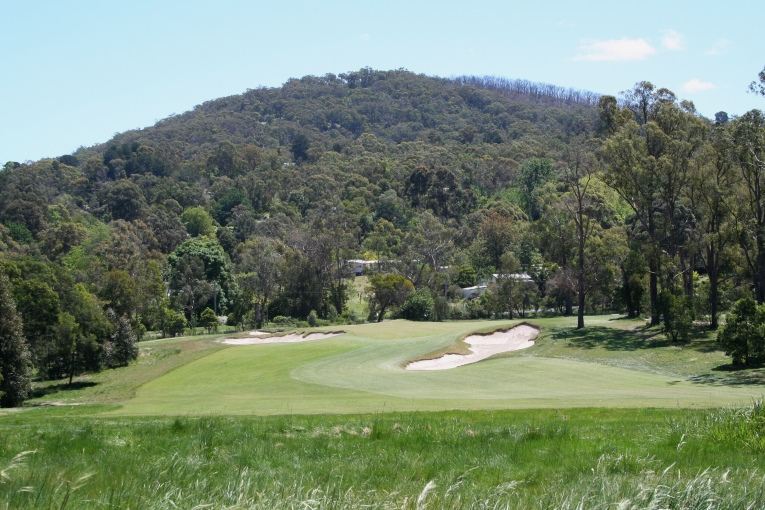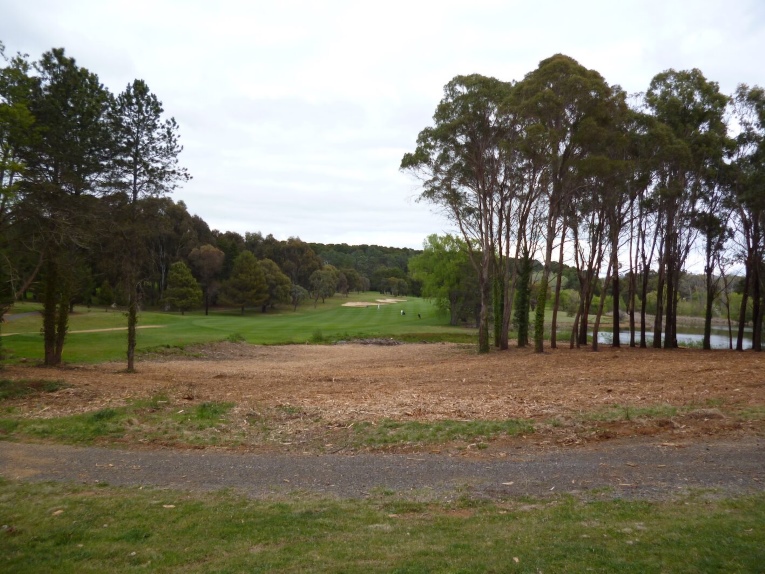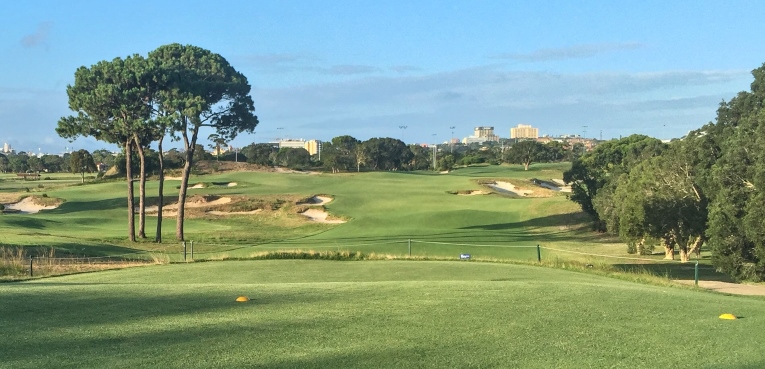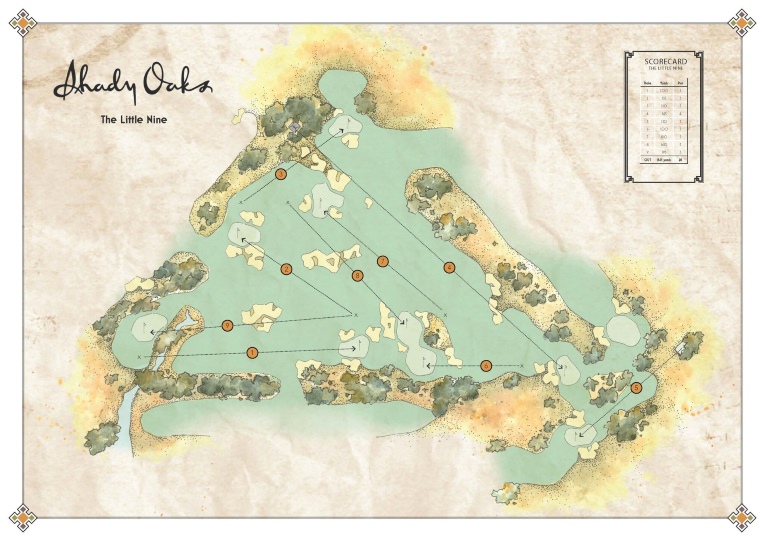Feature Interview No. 2 with Michael Clayton
September 2016
What was it like caddying in the 2016 Rio Olympics?
I’ve always enjoyed caddying – it’s how I started in golf – and Su (Oh) and I have done about a dozen tournaments together now beginning with the 2014 Australian Open at Victoria – so it’s very occasional but great fun.
I have been an Olympic cynic ever since Australian sprinter Raelene Boyle finished second in the 100 and 200 in Munich to a drug fuelled East German. Why, I thought, would golf want to be involved with a movement where cheating and disrespect for the opponent is clearly and historically a part of what goes on? Fortunately we play a game, whilst not immune from dishonesty, that is pretty decent.
Then you get there and it’s a bit like what Geoff Ogilvy said of Oakmont before this year’s U.S. Open. ‘It (Oakmont) does everything to make you want to hate it but you still have to love it.’
Both the men’s and women’s events were really exciting, all who were there embraced Olympic golf and my assumption is those who passed must have a tinge of regret. Su played pretty well – T13 at 279 – and she should be a genuine contender by the time Tokyo comes around.
What did you think of the Gil Hanse design?
I guarantee Su was the only player in the field who’d heard of Tom Simpson. One player even asked me if Gil was a man or a woman.
She knows a ‘Tom Simpson course’ is one where ‘the middle of the fairway is never the ideal line to the hole – except perhaps once a round for the sake of variety.’
She doesn’t play too many ‘Tom Simpson’ courses on the tour but enjoys them and understands them when she does. Rio was definitely a ‘Tom Simpson course’ and a big part of the success of the event.
The fairways were wide but driving to places from where you could score well was demanding and often risky. In the first round she got onto the par 5, 10th hole in two but only because she pulled a drive a touch and ran it down close to the water. It was never going in but it scared her/us and the rest of the week she gave it a wide berth – and couldn’t get to the green as a consequence.
It’s always interesting to see how players (and caddies) make decisions and hit shots when they are under the pressure of championship golf as opposed to playing golf free of the burden of card and pencil.
The course showed long, green grass has very little place in making interesting golf and short grass around greens is not only a great hazard it offers so much more variety for play around the greens.
The short par 4 16th came at the perfect time in the round and is a great hole – one which would fit right in on the sandbelt and its world-class collection of sub 310 yard holes. It asks a simple question (which changed as the pin moved) but the answer was particularly vexing and it was interesting to see the variety of ways the players tried to answer the questions it posed. The greenside bunker on the right is pretty much dead – like 10 at Riviera it’s all but impossible to hit the green from its depths. The LPGA seem to play many silly ‘drivable’ par 4s which are little more than long par 3s with a water hazard on the edge of the green.
The par 5s, aside from the 1st, had bunkers right where you didn’t want them because they left that awful 30 – 70 yard bunker shot no one plays with confidence.
The short holes had a sandbelt feel. The 4th was remarkably similar to the old 15th at Huntingdale – a hole Gil never saw. They asked for a variety of shots – both length and shape. Su doesn’t fade the ball with any comfort or ease so the 4th found her out with its small, left to right green and steep bank off the left. We didn’t even have to acknowledge to each other in the first practice round it would be a problem hole – we knew it and sure enough she made a five on the first day by going long and left. The rest of the week she just scrapped by with three pars but it showed her weakness – as all good courses do eventually.
Likewise, the 13th needed a fade off the tee and laying back to avoid the left bunker turned an easy hole into a harder than it needed to be. It was a bad six there on the last day which cost her a chance of winning the bronze medal. The second shot (long and left into an awful spot in the back bunker) was the one time all week she/we hit both the wrong club and the wrong shot. The right shot with the wrong club would have been acceptable, as would the wrong shot with the right club. I knew it already but I really understood after we finished why caddies beat themselves up over their own stupid mistakes. I should have known better.
Definitely sounds like it was neat to have played a part in something so global. Moving on, let’s talk about your first design Ranfurlie, a thirty-minute drive south of Melbourne. What are you most proud of as the course sits today?
Ranfurlie was our first 18-hole course and they are hard commissions to win in Australia where so few new courses get built. It’s a polarising course, one which some think of as just a paddock with 18 flags and a bunch of holes running up and down.
I like it because I find it interesting to play. It’s a windy site and one with few trees to begin with and the holes obviously change with the wind quite a bit. Like all the sandbelt courses it’s a thoughtful test, the bunkers are well placed, look good and sit well with the better courses in Melbourne. Despite its strengths, it’s hardly wildly popular but in time I think people will increasingly see it’s a good course.
Playing angles even on the straight holes and par 3s manifest themselves at Ranfurlie based on greenside bunker placement and/or angled greens. Where did you learn such?
The course which most promotes the same in Melbourne is Commonwealth, a course I’ve always liked and admired.
At almost every hole at Commonwealth the middle of the fairway is rarely the best place to play because of the orientation of the greens and the position of the bunkers. There are a lot of straight holes at Commonwealth but they don’t play in a straight line. It’s not to say the other courses of the sandbelt don’t show off the same principle – it’s really the basis of all the strategies in Melbourne and you soon learn to look to where the hazards are and play close to them. We incorporated that philosophy into play at Ranfurlie.
That and the requirement to shape the ball into the par 3 greens or take on a difficult straight shot over the trouble.
Another course early in your career was RACV Healesville, a 5,500yd par 68 course 90 minutes north of Melbourne. Though set on heavy soils, the course engenders great affection largely because of the playing interest injected by its creative greens. In some ways, is it easier ‘to take the reins off’ on a design of such modest length than if it measured a lot longer?
Healesville was poor course owned by a big Melbourne insurance business. They committed to rebuilding the course and we shortened it, albeit by only twenty yards. It’s a par 68 through some creative accounting at the par 5s – both of which are barely 460 yards in a straight line.
Mike Cocking ran the project and we certainly build some wild greens we never would have made on a ‘normal’ sized course.
Did your experience at Healesville make you more or less willing to accept a commission on non-sandy sites?
It was the first course in greater Melbourne to show you could build attractive bunkers in clay. Previously, all the clay-based courses featured average bunkering and people in Melbourne assumed good bunkers could only be made in sand. Likewise every hilly course in the city was poor and all the good ones where on quite flat land – excepting Royal Melbourne – and people assumed good golf was flat golf and hilly golf was bad golf.
We did miss out on a job a while ago (one we needed at the time) on a very bad piece of land. The course was never built but even if we had done an amazing job it would have been a bad course. I’d like to think we would pass on a similar opportunity if it came again. We have seen a couple of tremendous sites on poor soil and we absolutely would have loved to build the courses but sadly neither saw the light of day.
Have the characteristics of the Healesville course (short but loaded with character) influenced your design philosophy elsewhere?
Probably not – I’d like to think we built character into whatever we do but building short 3s, 4s and 5s is to make the type of holes golfers seem to like. Healesville has a bunch of those holes and it’s the sort of course the majority should play most of the time. Golf is more fun when you hit some greens in regulation. I play with a old bloke most Saturdays at Metropolitan and he barely hits a green now but he can hit eight or nine at Healesville whilst still thinking he’s playing a course asking him to both think and hit good shots.
You have been working at what is now Peninsula Kingswood Golf Club for well over a decade. First, you worked on the North and now the South is getting ready to re-open after a massive overhaul. The courses seem to complement each other with the intimate North calling for accuracy while the South is more sprawling and allows a touch more leniency. As you worked there, did you try and heighten (even if just slightly) the playing differences so that the members feel like they have two different playing experiences?
We did a lot of work on both courses ten to fifteen years ago and both were improved – the North more than the South – but subsequently the club merged with Kingswood, a sandbelt course 20 minutes closer to the city and the subsequent financial position allowed for the complete rebuilding of both courses.
Always stretched for the money to match the maintenance and attention to detail of Royal Melbourne or Kingston Heath, the work was in part to raise the quality of the playing surfaces, especially the greens.
The original North was a bad course, full of odious doglegs (too short to the corners leaving driving over trees as the alternative to irons off the tees) on the second best piece of land (behind Royal Melbourne) on the sandbelt.
Peter Thomson broke the back of worst of the routing problems in the early 1980s and we finished it in the early 2000s. Still, we really only picked at it and this current work gives us an opportunity to do the whole course at once and finally exploit the quality of the land.
The South was always a bigger, longer and harder course and for years the better of the two. It will remain the more difficult course, less charming probably but the more appropriate tournament course and hopefully the club will finally get to show it off in a big event.
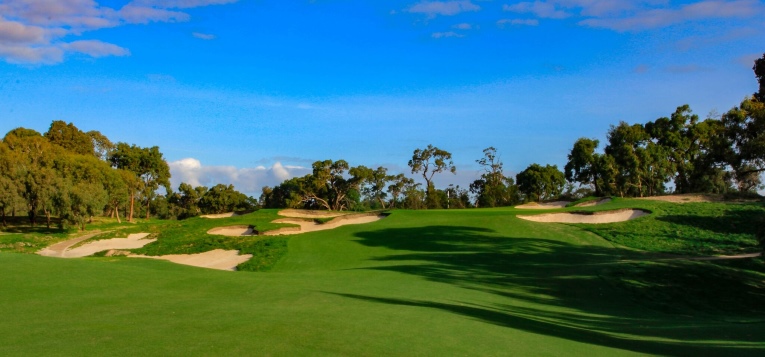
The 14th on the South Course. Peninsula Kingswood GC deserves to be recognized these days among the leading 36 hole facilities in the world. Photograph courtesy of Larry Lambrecht.
You and I are both enormous fans of St. Andrews Beach yet its choppy beginning seems to hinder it from getting the respect it deserves. You have a house near there, were involved in the project and have toured it a bunch. Do you also put it around the top 5 in Australia?
My top four are Royal Melbourne’s West, the two courses at Barnbougle and Kingston Heath. After that it isn’t so clear where the next fall and many would put the new course at Cape Wickham in the best five. St Andrews Beach is in the next five for me but many seem to point to the things they don’t like – the blind opening green, the siting of the 3rd green, the size of the 10th green and the tee shot at the 13th – and mark the course down on that basis alone.
I don’t have an issue with any of them and there are many first-class holes and so many interesting shots to play.
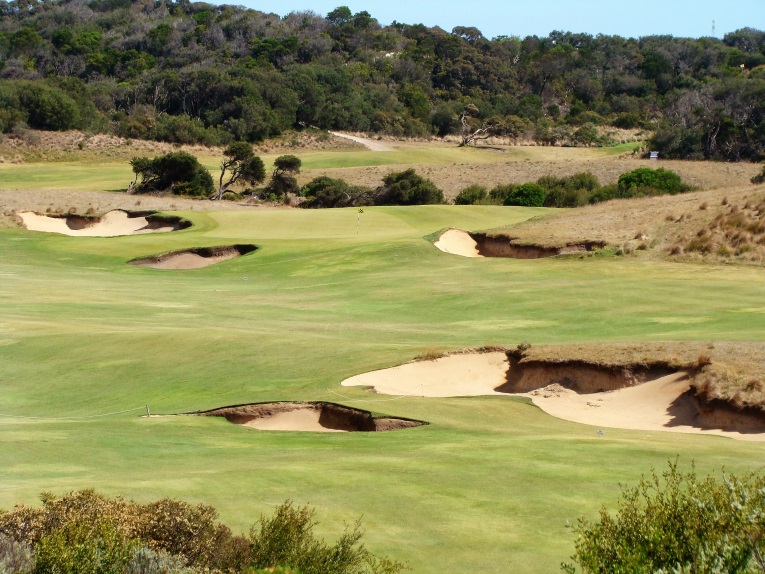
The scintillating view from the 7th tee at the hugely underrated St. Andrews Beach. The fairways even look fast and bouncy in the photograph.
What is a bit of its history? How did the existing course come together?
Originally it was a 27-hole course with Tom Doak collaborating with Ian Baker-Finch. There was a main 18 and a short nine with a real estate component. Then the owners decided to use Peter Thomson and Ross Perrett before finally asking, post Barnbougle, if we would like to do it with Tom – if he was still interested.
The real-estate part of the project was rejected by the local council and the owners decided to do 36 holes. We routed a full 18 (which was never built) and Tom combined ten holes of his 18 hole course with a number of holes from the short course to make the current 18.
Mike Cocking rearranged the 10th because of a problem removing trees. What was originally a three and a four became a tough four followed by the par 3, 11th.
There were only seventeen holes until Tom found the found the par three, 16th. Mike and I had one plan but Tom came down, looked, slept on it for a night and announced a solution at breakfast. The original 17th tee (playing to the current 17th green and a really good hole) became the tee for the long par 3 16th and the 17th tee moved two hundred yards without detracting from the hole. The new 16th tee drove straight over the planned 1st green on the other course but it was movable and it was never built anyway.
Once the routing was set, St. Andrews was an intensely quick build. Is that the best kind? I think of places like Sand Hills and the greens at Yeamans Hall were the project moved along chop-chop and somehow the end results are better than if man overthinks things.
It was – Tom predicted somewhere inside 12 months and it was pretty close. There wasn’t much soil to move, the green sites were all there and Brian Slawnick built the bunkers at a good pace.
What are three of your favorite shots there?
I like the second shot into the 3rd – but it’s a pity more wasn’t cleared off the dune on the right and allowed for the option of coming in that way.
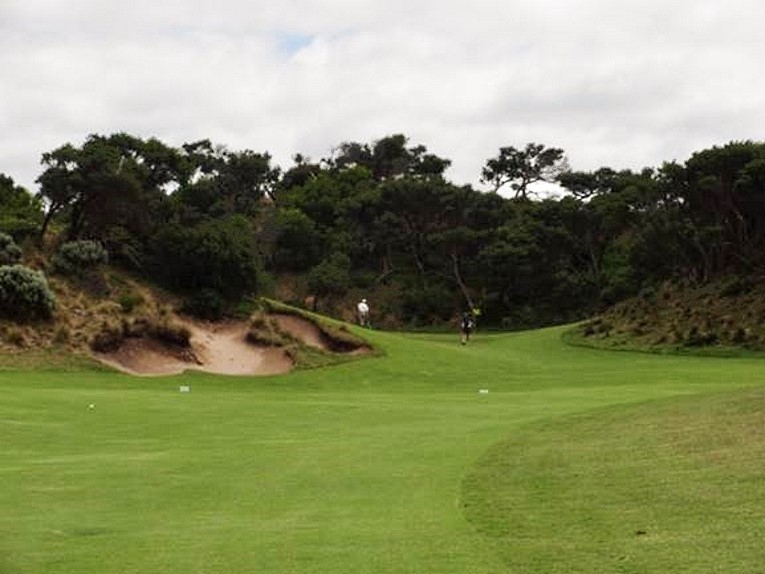
The approach into the 450 yard + 3rd would be even better if the right hillock was cleared and could be utilized.
The tee shot at the 8th is always interesting because there is one flat ledge on the right from where the green is visible. Drive it anywhere else and some or all of it is blind. 15 is somewhat similar with its 70 yard wide fairway but a 15 yard slot to drive into if you want to see the green.
The tee shot at 18 is always interesting no matter the wind – something which changes the line quite a bit.
How do you play the teasing but pugnacious second hole?
I can’t drive it far enough to get on the green so for me I aim a tee shot at the middle bunker and kick it just to the left of the hazard. It’s one of those bunkers you never go into but it still controls everything the majority do from the tee. Only the longest hitters don’t have to worry about it.

The uphill 2nd at St. Andrews Beach is one of the best of breed short par fours where anything from an eagle to a triple is readily possible.
The pitch is blind from down there and often into the wind. Anyone who can really hit can drive it onto the green with a running draw coming in from, and using the slope, on the right.
Is there any hope for more work down in the Mornington Peninsula dunes? In terms of dunes well suited for golf that are also near a major metropolitan area, it might be the best spot in the world.
Everyone is saying there is a saturation of golf courses in Melbourne and on the Peninsula and maybe there is – but I refuse to believe there can ever be a saturation of first-class golf.
The sandbelt clubs had an opportunity to buy St Andrews Beach for a song and passed on it, a decision people in time will come to see as a mistake. There are clubs with poor courses in Melbourne but not so far from the Peninsula which could merge, keep one course in Melbourne and build on perfect dunes within an hour. With driverless cars on the way it won’t be that onerous a trip and the quality of the golf will be immeasurably better. Of course, for some the quality of the golf isn’t a consideration – but maybe that is why the clubs offering what we would consider sub-standard golf (and members happy to play Doak 1s and 2s) are struggling to stay afloat?
What are you doing at Royal Canberra? The land has nice, flowing movement.
Both golfers and magazines have called it ‘Australia’s Augusta’ but it was a very superficial comparison based on the pine trees and the hills. The golf was narrow, lined with long grass and nothing like Augusta. It was though a place suited to wide fairways, greens surrounded by short grass, bunkers cutting right to the edges of the greens and even a dogleg left par five (the 15th) with a creek cutting, on a diagonal line, across the front of the green.
The greens drained poorly as did the bunkers – which were cut too far from the greens they were protecting and had two or three different mowing lines between them and the edges of the greens.

… and after with the natural feature of the lake and the increased fairway width creating all sorts of playing angles.
The 5th and the 12th were two bad dogleg holes, both turning against the slope of the ground and moving tees quite a way was the only way to fix them. 14 was a decent hole but one which made no use of the lake on the right and Commander Harris (the original designer) had drawn a hole which played from what is now the par 3 13th tee to the 14th green but it was never built. 13 is a good hole but we cut some extra tees up the hill back toward the 13th tee, removed the trees on the right and incorporated most of the elements of Harris’ original hole into the new 14th. It was a risk but it turned out well.
15 is the dogleg left with a new creek cut across the front of the green and it’s a much more interesting hole than the original.
Your work on the greens at The Lakes seems to cause gnashing of the teeth with professionals and compliments from other architects, so … congratulations on a job well done!
Some pros liked it and others were not so keen but for them it’s usually case of black and white. A course is either great or awful. I don’t expect them to like every element but there is so little informed or nuanced debate. Greg Norman came in and said he liked the old course better but there had been a number of incarnations of the course since Von Hagge and Devlin redid it in the early 1970s. Which old version did he like? I liked the old version too but it was long gone by the time we started work.
There are some greens with big contours and mostly they work pretty well. One which didn’t was the 15th and we redid it and made it much better. It’s always annoying to have to do that but sometimes the only way to stop the angst – and in this case the angst was well-justified.
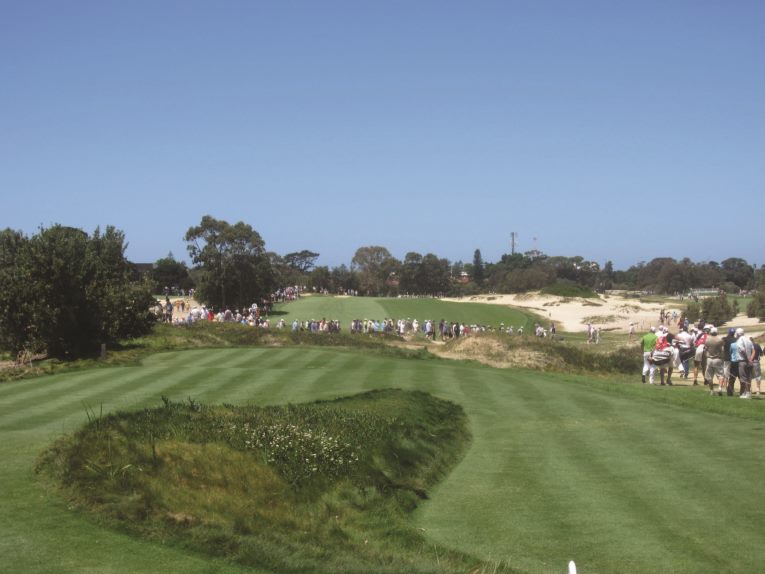
… and after. Finally, a course in the eastern suburbs of Sydney with the visual appeal of the courses in Melbourne.
14 is a huge and wild green not dissimilar to the 13th at Barnbougle – a green you either love or hate and one the ‘fair’ crowd are never going to accept. It is a short 5 (510 yards) across a lake and Von Hagge and Bruce Devlin incorporated elements of Augusta’s 13th into the hole. If you drive right you play a long second off a severe slope but drive left by the water and you have a flat lie and a shorter shot. But they built bunkers between the water and the front of a small green and it never made sense to us not to have the green come right to the edge of the water as MacKenzie and Jones did at Augusta. The green site was massive and one way to use it was to make the whole space putting green. There wasn’t much point to building a massive flat green on a short 5 and so we built something wild. I like it – some don’t but they can get over it.
Many are critical of the small, and demanding 13th green. I saw Adam Scott hit the most perfect 3 wood onto the green in the 2012 Open but if you miss it it’s as hard to save 3 as it is to make 3 after laying back and hitting a simple pitch from 60 yards. After seeing Gil’s great but brutal 16th green in Rio at the end of a quite similar type hole, I have even less time for the critics.

Geoff Shackelford’s photograph above captures Tiger Woods hitting an approach to the tiny, scary 13th green at The Lakes. How much more inspired is a green complex like this than one with an insipid pond lamely placed to one side?!
How difficult is it to build creative greens when you know the club wants to host professional events whereby the club will want to see the greens stimp at 12+?
We don’t even consider it. We built what we thought would be interesting and enduring for the members. The pros – who come in for three, four or five weeks in ten years – can manage. The trick always at The Lakes, as it is at all the best tournament courses in Australia, is to get the greens firm without having them running at 13 and 14.
Claude Crockford was preparing greens at 13 in the mid-70s and it was seen in Melbourne by pretty much everybody as the way golf should be. I suspect Peter Thomson was an exception as he often said slower greens were more difficult to putt.
I thought ‘fast was best’ too for the longest time but now it just seems to border on the silly. Of course the madness of the modern ball and driver has meant the ‘fast green’ crowd use the ‘it’s the only way to defend the course’ argument now that it’s so short for the best players. It’s no wonder every tournament round at Royal Melbourne is interminably slow. The 1972 World Cup – in teams of 2 (and groups of 4) – featured rounds over six and a half hours (!) so this is hardly a recent problem.
Where do you stand at Bonnie Doon in completing your work? It has been a lengthy project but the photographs show an incredibly more exciting course than the one I played in the 1990s.
I think we won the job (and risked losing it) by impressing on the committee it was quite amazing they could have a course not ranked in the top 100 in the country (not a particularly high bar when compared with America and Britain) on such a good piece of land.
We have just shaped the five holes ‘across the road’ leaving only the new 1st (the old 18th in reverse) and the old 10th and 17th holes to finish up.
They club had some spare land where we did the new 14th and 15th holes – something that freed up much needed space in other parts of the course and solved a couple of siginicant boundary problems.
There are a number of vastly improved holes and the improvement was only possible by removing trees. It’s annoying to have a reputation as a ‘tree hater’ without first having a sensible discussion about the merits or demerits of the holes we changed by removing trees.
How would you compare and contrast a game at Bonnie Doon to that at The Lakes nearby?
They are both built on the same stretch of Sydney’s sandy, dune land that is perfect for golf. Probably as interesting a contrast is between The Lakes and The Australian where their 14th green is just across the road from the 13th green at The Lakes. They started off as brother and sister courses – same look and design philosophy – and they couldn’t be further apart now.
Bonnie Doon is shorter and easier but hopefully just as interesting. There is no water in play in stark contrast to The Lakes and while Bonnie Doon has couch fairways The Lakes are kikuyu. Kikuyu has a bad reputation in Australia but year round the fairways at The Lakes are some of the best in the country. They play well and they feel right all year in contrast to the dormancy of the couch in the winter.
An architecturally aware player playing both courses would recognize the architects were asking quite similar questions of their shots and their decision making.
What three courses have you seen since our last Feature Interview (October, 2001) that mightily impressed you?
I’ve seen a lot since then and it’s obviously hard to pick just three. NGLA, Sand Hills and Prestwick are all interesting in their own ways, what they stand for and represent. We all need reminding how wild and unrestrained by convention early golf was and how accepting early golfers were of what would now be seen as ‘silly’ or ‘unfair.’ Prestwick and North Berwick are the prime reminders.
Was there a single design point in particular that you walked away with from each?
NGLA for its perfect capturing of fun and interesting – and its ability to do it enduringly. Maybe only The Old Course does it better.
Sand Hills for its remoteness and the almost complete absence a man made structure – aside from the half way house. And, of course, the great holes.
Prestwick for the madness of it all.
What three courses would you most like to see for the first time?
Oakmont, Seminole, and Tara Iti.
You always praise your partner Mike Cocking and his work. What is his background? How do you collaborate?
Mike was a good enough amateur to finish 4th in the 2001 Australian Masters behind Colin Montgomerie. He was studying environmental engineering when we played together in a match between local pros and the state golf team.
He wrote me a letter asking if he could so some work for us and we paid him initially by the hour for the time he could manage between study and playing top-level amateur golf.
It evolved into a full time position and hiring Mike and Ashley Mead in 2000 was a perfect example of hiring people who are better than you. They have both done great work with both the old and the new business.
We all work together, normally see the same things, and Geoff and I most often defer to them if they make a good case for something we are not seeing.
A few years ago Geoff said to me. ‘We would be screwed without these guys, wouldn’t we?’ He is right.
Geoff Ogilvy is unique in that he has a genuine passion and knowledge on golf course architecture plus he can still murder the ball. How does talking and playing with him improve your finished product?
He grew up caddying at Royal Melbourne and the caddies could all play the course after four o’clock. It was a pretty nice deal when you think about it and lots of good players came up that way.
Geoff was a small kid and pretty soon he worked out he could only hit the green with long second shots if he played from the right parts of the fairways. Hitting the ball down the middle of the fairways didn’t work very well on many of the holes.
Even as a small boy, he was understanding there was more to golf than just hitting the ball and that the questions the architect was asking were an important, integral part of the game.
It’s always good for clubs worried about their tournament relevance to hear from him his now well-worn line ‘Why would anybody design a course for us? No one would want to play it.’
Unlike America and Britain, all our best courses want tournaments and so need to stay somewhat relevant for the best players. Still, they will play the World Cup at Kingston Heath in November and as great as the course is, it will be still short for those guys despite adding back tees at eleven holes in the past ten years and stretching it within an inch of its life.
Tell us about your project at Shady Oaks, Ben Hogan’s former hang out.
It came out of a bizarre confluence of circumstance and Bill Coore was more than helpful to us. The first job is to rebuilt the ‘Little Course’ where Hogan used to practice. It’s basically a par 3 course with one par 4 but the greens are very rudimentary. We’re rebuilding them all, redoing the bunkers, adding some and trying to make as many extra holes as we can amongst the nine hole course.
For example, there is a great hole from up by the 5th tee and his famous tree down to the 3rd green. Also the par 3, 9th is a terrific medium length par four from a new tee on the other side of the 4th fairway. Essentially the plan is to have a regular 9 hole short course but also a course where members can go out and essentially chose the holes they want to make up by playing from ‘anywhere to anywhere’ From the 7th tee you will be able to play a long draw into the 2nd green, a long fade into the 3rd green and a straight shot into the 7th green.
In what is a real coincidence Su Oh moved to Dallas to be close to her teacher Cameron McCormick and she has just joined Shady Oaks where Mike Wright has been very kind to a young woman in a strange city a long way from home. I made sure Mike Cocking made a green where she could work on that left to right shot and knowing her she will wear some turf out up there as she channels Ben Hogan.
The plan is to close the big course in a couple of years and rebuilt all the greens and bunkers as well as fixing the few things not working as well as they should.
It reminds me of Royal Canberra in many ways. It’s a great club, the land is interesting, the course is in good condition, it feels good but it could be so much better.
Even before we start, Mike Cocking has gone through all the mowing lines with the Super, Brent Doolittle, and he has embraced the concept of way more short grass and much less rough around the greens. It will make a big difference to have it embrace a bit of an Australian course – which brings us back to the beginning and Rio.
The End



